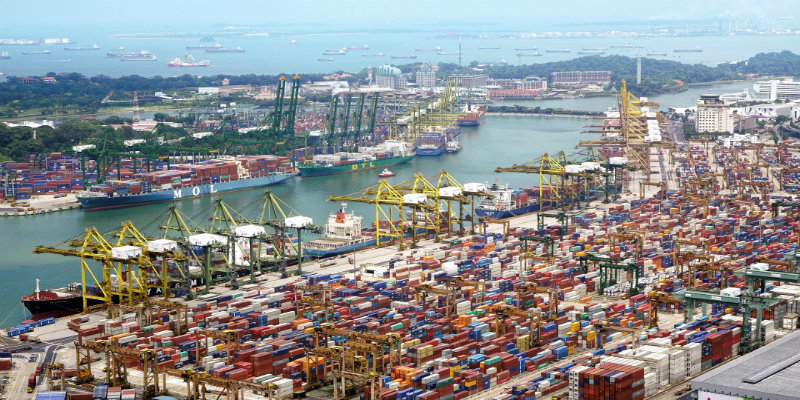Exports are often seen as a solution to the problem of sustained economic development, and indeed they can be. The East Asian Tigers—Singapore, Hong Kong, Taiwan, and South Korea—are perhaps the most commonly cited nations that have risen from poverty to prosperity primarily through exports. Yet at the Christensen Institute, we think about exports and how these nations developed slightly differently. Our research indicates that, while exports helped these nations rise to prosperity, innovation was at the core of their export activities.
Consider Singapore, one of the world’s most prosperous nations today, with an export to GDP ratio of 172%. Assessing Singapore’s economy from a macro level, it’s understandable to conclude that Singapore has grown solely because of its exports. 50 years ago, when it was just getting its start as a poor, sovereign city-state, Singapore was exporting matches, fish hooks, and mosquito coils to the world. Today, it exports aerospace, semiconductor, and biotech products. Singapore, over time, has learned how to export more and more sophisticated products—products that resulted from innovation. Cementing its reputation as an innovation hub, it now serves as a regional headquarters for some of the world’s largest and most innovative companies, such as BMW, Roche, Novartis, Microsoft, and Apple. If the small island nation kept focusing on exporting matches, fish hooks, and mosquito coils, it would likely not be where it is today. It may have sustained its export base, but would have lost its shot at enduring prosperity. Researchers at Harvard and MIT explain why this is the case.
Harvard University professor Ricardo Hausmann, who developed the Atlas of Economic Complexity with MIT statistical physicist César Hidalgo, explains a useful concept called, “economic complexity.” He defines economic complexity as “a measure of the knowledge in a society that gets translated into the products it makes.” He goes on to note, “the more complex a country’s economy, the stronger its infrastructure and the more adaptable it is to market changes.” In essence, “prosperous societies are those that have the knowledge to make a larger variety of more complex products.” So, while it’s true that Singapore is an export-based economy, it is perhaps more accurate to identify it as an “innovation-based” economy. For clarity, let’s define innovation as “a change in the process by which an organization transforms labor, capital, materials, or information into products and services of greater value.”
Categorizing Singapore’s economic ascendancy as accurately as we can matters because the way we categorize problems and solutions often dictates what we recommend to others when they find themselves in similar circumstances. In this case, if we believe the critical unit of analysis or the critical driver of economic development for Singapore and the other East Asia Tigers is fundamentally exports, then we will recommend that other nations focus on growing their exports. However, while many other countries are focusing on growing their exports, they are not seeing similar results. One of the reasons for this is that there are diminishing returns to export-led growth, which are exogenous in character. American University economist, Robert Blecker, explains that, “the market for developing country exports of manufactures is limited by the capacity [and willingness] of the industrialized nations to absorb the corresponding imports.”
Consider, for example, how this phenomenon played out in Lesotho, the small Southern African country, after the Multi-Fiber Agreement (MFA) changed. The MFA, which set the rules for worldwide trade in textiles from 1974 to 2004, expired on January 1, 2005. Because the MFA had limited the volume of exports participating countries, such as China, had been allowed to export into wealthier countries like the U.S., Lesotho had been able to compete in the global textile market. Once those limits were lifted, Lesotho couldn’t as easily compete with China’s low cost of production. This change resulted in Lesotho’s textile industry losing about a quarter of its jobs almost overnight.
At its peak, Lesotho’s textile industry employed 50,000 people. It now employs somewhere around 37,000. And because they’re low-wage jobs that can easily be moved to other countries that offer even lower wages, they’re vulnerable to a race to the bottom scenario in which competing countries continually reduce wages and labor standards in order to attract investments. In 2006, textiles accounted for 21% of Lesotho’s GDP; by 2013, it accounted for just 12%. To be clear, the textile industry in Lesotho has been good for the country and many of its citizens who are now employed. But it hasn’t sown the seeds of prosperity in the country since many of these jobs are low-wage and hardly move the needle on vibrant economic development.
Conversely, when we assess wages in the East Asian Tigers, we see that they have raced upwards, not downwards. And wages in China, though behind, are racing upwards too. These nations have not only increased their wages and labor standards, but they have also increased the nature and quality of goods they trade. China, for instance, exported approximately $155 billion worth of advanced technology goods to the United States in 2015. In the 1980s and 1990s, almost all exports from China were low-value and labor intensive products like toys, footwear, and textiles.
To reduce Singapore’s rise to a story of exports alone would miss the critical role that innovation played in the nation’s path to prosperity. Exports, through our lens, are an important indicator of the innovation activities in an economy—and by extension, can signal a nation’s level of prosperity. By themselves however, they do not tell the whole story.


